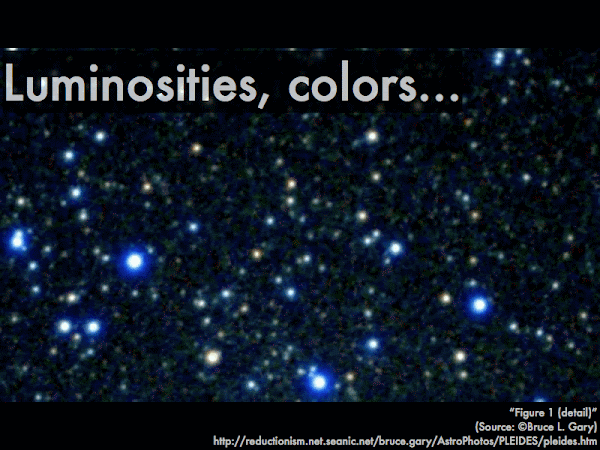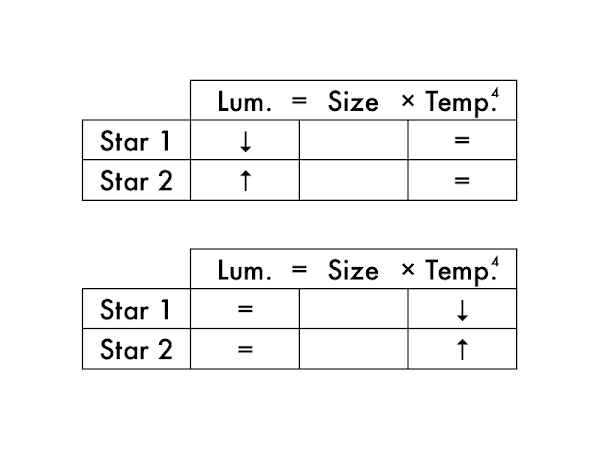Cuesta College, San Luis Obispo, CA
Students have a weekly online reading assignment (hosted by SurveyMonkey.com), where they answer questions based on reading their textbook, material covered in previous lectures, opinion questions, and/or asking (anonymous) questions or making (anonymous) comments. Full credit is given for completing the online reading assignment before next week's lecture, regardless if whether their answers are correct/incorrect. Selected results/questions/comments are addressed by the instructor at the start of the following lecture.
The following questions were asked on reading textbook chapters and previewing presentations on parallax, distance, apparent magnitude, absolute magnitude, Wien's law and the Stefan-Boltzmann law.

Selected/edited responses are given below.
Describe something you found interesting from the assigned textbook reading or presentation preview, and explain why this was personally interesting for you.
"The star sizes--stars are one of my favorite things to learn in astronomy."
"Not sure any of it is, because I am still trying to grasp the subject matter."
"How the distance between us and the stars makes some stars seem brighter than others or vice versa. This is obvious, but I had actually always believed the sun was the brightest star we had, totally wrong."
"As an art student, I find it interesting that blue is the hottest color of star because blue in normally associated with cold things, such as winter or ice and stuff like that."
"The ranking of brightness of the stars. the brightest star starts off with a negative rather than a positive. "
Describe something you found confusing from the assigned textbook reading or presentation preview, and explain why this was personally confusing for you.
"How to tell the difference in luminosity when comparing stars that may be very different in size, but then have hotter or cooler colors to balance out the size difference."
"Why exactly is blue the hottest color?"
"The dark lines in the color spectrum were extremely confusing to me (pre-lecture) but you did a great job clearing that up."
"The meaning of parsecs and how you would estimate how far away a planet is or would be."
"The subclasses for the spectral sequence. I'm confused as to how it is read. Would A0 be greater than A4 or the other way around?"
Explain how apparent magnitude and the absolute magnitude are defined differently.
"Apparent magnitude is the brightness of a star as seen by an observer on Earth, without compensating for distance. Absolute magnitude is the actual brightness of stars when placed 10 parsecs away."
"Apparent is what it looks like, absolute is what it actually is."
"Well they do different things."
Suppose the sun was moved to a distance of 10 parsecs away. As a result, its __________ magnitude would become dimmer.
absolute. ****** [6] apparent. ******* [7] (Both of the above choices.) * [1] (Neither of the above choices.) [0] (Unsure/guessing/lost/help!) [0]

(Only correct responses shown.)
1 (brightest): the sun, m = –27 [100%]
2: Canopus, m = –1 [93%]
3: Vega, m = 0 [86%]
4 (dimmest): Kapteyn's star, m = +9 [86%]
Rank the brightnesses of these stars (1 = brightest, 4 = dimmest; there are no ties), if relocated to 10 parsecs from Earth.
(Only correct responses shown.)
1 (brightest): Canopus, M = –3 [71%]
2: Vega, M = +0.5 [79%]
3: the sun, M = +5 [71%]
4 (dimmest): Kapteyn's star, M = +11 [79%]
Determine whether these stars get dimmer or brighter when relocated from their original positions to 10 parsecs from Earth.
(Only correct responses shown.)
The sun: gets dimmer [86%]
Canopus: gets brighter [71%]
Vega: gets dimmer [36%]
Kapteyn's star: gets dimmer [43%]
Rank the temperatures of these main sequence stars (1 = hottest, 4 = coolest; there are no ties).
(Only correct responses shown.)
Hottest: blue main sequence star [73%]
Second hottest: white main sequence star [64%]
Third hottest: yellow main sequence star [79%]
Coolest: red main sequence star [79%]
Rank the temperatures of these supergiant and dwarf stars (1 = hottest, 4 = coolest; there are no ties).
(Only correct responses shown.)
Hottest: blue supergiant [79%]
Second hottest: white dwarf [79%]
Third hottest: yellow supergiant [79%]
Coolest: red dwarf [79%]

dimmer. * [1] brighter. ********* [9] (These stars would be the same size.) *** [3] (Unsure/guessing/lost/help!) * [1]
Two stars (equally far away) have the same brightness, but one star is cooler, and the other star is hotter. The __________ star will be larger in size.
cooler. ******** [8] hotter. *** [3] (These stars would be the same size.) ** [2] (Unsure/guessing/lost/help!) * [1]
Ask the instructor an anonymous question, or make a comment. Selected questions/comments may be discussed in class.
"I've found this section to be somewhat more confusing than past sections."
"I'm sorry, but I need to figure this out more."
No comments:
Post a Comment